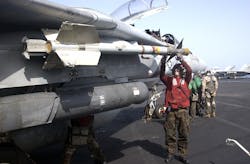Navy asks Raytheon to build lot-20 AIM-9X advanced air-to-air missiles for U.S. Navy, Air Force, and allies
PATUXENT RIVER NAS, Md. – U.S. Navy aerial warfare experts are asking Raytheon Technologies Corp. to build several hundred AIM-9X precision short-range infrared-guided air-to-air missiles for jet fighters and other combat aircraft under terms of a $392.4 million order announced last month.
Officials of the Naval Air Systems Command at Patuxent River Naval Air Station, Md., are asking the Raytheon Missiles & Defense segment in Tucson, Ariz., to build lot-20 AIM-9X block II and block II+ air-to-air missiles.
These air-to-air missiles are for the U.S. Navy, Air Force, and the governments of Australia, Belgium, Denmark, Finland, Indonesia, Israel, Japan, Kuwait, Malaysia, Morocco, Oman, the Netherlands, Norway, Poland, Qatar, Romania, Saudi Arabia, Singapore, Slovakia, South Korea, Switzerland, Taiwan, Turkey, and the United Arab Emirates.
The order is for lot 20 AIM-9X Block II and II+ tactical missiles, captive air training missiles, all-up round tactical missiles, captive test missiles, special air training missiles, advanced optical target detectors, Block II and II+ live-battery guidance units, inert-battery captive air training missile guidance units, Block I and II propulsion steering sections, electronic units, training missiles, tail caps, maintenance, sectionalization kits, containers, and spare parts.
The AIM-9X is an infrared-guided heat-seeking missile that equips most jet fighters, fighter-bombers, and other offensive combat aircraft in the U.S. arsenal, and is for shooting down enemy aircraft close-by. The AIM-9X works by homing in on an enemy aircraft's hot engine exhaust. Variants of the AIM-9 Sidewinder have been deployed since the 1950s.
The AIM-9X is among the latest versions of the AIM-9 missile family. It entered service in 2003 on the Navy F/A-18C Hornet fighter-bomber and on the U.S. Air Force F-15C jet fighter. It has an imaging infrared focal plane array seeker with 90-degree off-boresight capability for accuracy.
The missile is compatible with helmet-mounted displays such as the U.S. Joint Helmet Mounted Cueing System, and features 3-D thrust-vectoring control for increased turn capability. The AIM-9X also includes an internal cooling system.
This contract involves the latest versions of the AIM-9X, called the AIM-9X Block II and AIM-9X Block II+. This newest version has lock-on after launch capability for use with the F-35 Lightning II joint strike fighter and the F-22 Raptor advanced tactical fighter.
The AIM-9X Block II+ features specialized external materials to enhance aircraft survivability for the F-35. Until another version of the AIM-9X is developed that will fit inside the F-35's enclosed weapons bay, the AIM-9X Block II+ has stealthy coatings and structures to help reduce the missile's radar cross-section when the F-35 carries these missiles externally.
On this order Raytheon will do the work in Tucson, Ariz.; Andover, Mass.; Keyser, W.Va.; Santa Clarita, Goleta, San Jose, Valencia, Anaheim, El Cajon, San Diego, Chatsworth, and Claremont, Calif.; Hillsboro, Ore.; Ottawa, Ontario; Cheshire, Conn. (4%); Heilbronn, Germany; Simsbury, Conn.; Cincinnati, Ohio; Anniston, Ala.; Amesbury, Mass.; Sumner, Wash., and other locations, and should be finished by July 2023.
For more information contact Raytheon Missiles & Defense online at www.raytheonmissilesanddefense.com, or Naval Air Systems Command at www.navair.navy.mil.

